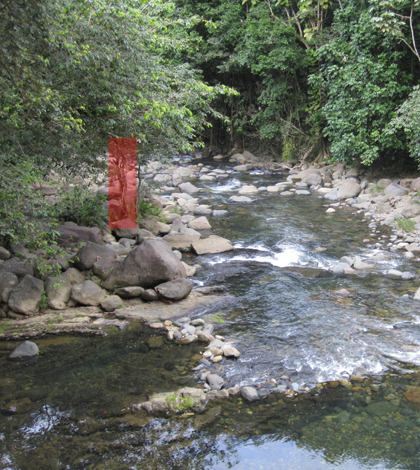Extreme Erosion In Rivers Not Always Linked To High Rainfall

Section of the Mameyes River showing normal state. A tree is marked for reference. (Credit: University of Pennsylvania)
Think that big rains mean high levels of erosion in rivers? Think again — the answer largely depends on the kind of river you’re looking at.
In rivers with gravel-sized and larger, coarse material, researchers at the University of Pennsylvania found that large storms only move about 50 percent more sediment than typical amounts of rainfall.
Much of their study was completed in the Puerto Rican rain forest, where a strong storm can drop a meter (3.28 feet) of rain in a single day. All the water rushes into mountain rivers and causes a torrent as the water overflows riverbanks and charges downstream.
The work began with an investigation of the Mameyes River in the Luquillo Critical Zone Observatory in northeastern Puerto Rico, where flash floods are common. The researchers set out to determine how often and how far particles on the riverbed moved in response to rainfall.
They placed radio frequency tags inside 350 grapefruit-sized cobbles on the riverbed and then checked their locations after numerous rains during the course of two years. A U.S. Geological Survey stream gage near their study site was also used to monitor the river water’s forcefulness.
Scientists saw that rainfall events strong enough to move the cobbles occurred about 20 times a year. But, even though the heaviest rainfalls could increase the river discharge 100 times normal, the storms moved the tracers only slightly farther than more typical rain events.
The researchers were a bit surprised with those finds, so they set out to determine if they could apply to rivers more generally. To do so, they gathered USGS stream gage data from 186 rivers on width, depth and sediment type as well as discharge over time.

Same section of the Mameyes River showing flood state. A tree is marked for reference. (Credit: University of Pennsylvania)
Analyzing the data, investigators confirmed that rivers transporting gravel-sized material rarely see flows that exceed the threshold of motion, or the flow strength at which sediment movement takes place.
While some rivers experience flows at the threshold of motion many times per year and others only once every few years, the scientists found a repeating pattern for flows above threshold. Not only did they find that those types of high flows were very rare, but they also found that the distribution of forces that exceed the force needed to move particles was the same for all of the rivers under study.
More specifically, they found that flows that were 1.5 times threshold were 100 times less frequent than threshold floods, and flows 2 times threshold were 100 times less frequent than that. The reason for this commonality, researchers say, is that the width and depth of river channels adjust to keep the forces of water flow near the threshold of motion.
Essentially, there is a sort of “speed limit” on erosion that rivers can control. High flows may mean more erosion in the short term, but the channel can widen to accommodate the higher waters, which brings forces on river beds back down.
With climate change expected to bring more intense precipitation in many regions of the globe, the findings indicate that, while these extreme rainfall events may at first lead to more flooding, river channels may rapidly increase their size to accommodate the flow.
As many landscape models have operated under the assumption that more variable rainfall equates with more erosion, the findings will likely trigger a new look at the connection between climate change and landscape change.
Full findings of the study, supported by the National Science Foundation, are published in the journal Science.
Top image: Section of the Mameyes River showing normal state. A tree is marked for reference. (Credit: University of Pennsylvania)




0 comments